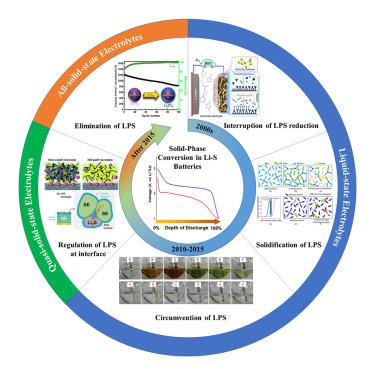Chem ( IF 23.5 ) Pub Date : 2022-05-13 , DOI: 10.1016/j.chempr.2022.01.002 Chao Xing , Hao Chen , Shangshu Qian , Zhenzhen Wu , Ameer Nizami , Xia Li , Shanqing Zhang , Chao Lai

|
The solid-phase conversion mechanism in lithium–sulfur (Li–S) batteries has emerged with many attractive advantages such as avoiding the parasitic “shuttle effect” of soluble polysulfides and allowing lean electrolyte operating conditions. Electrolyte regulation could be a vital strategy for taking full advantage of solid-phase conversion to realize high-energy Li–S batteries. This review aims to provide a comprehensive overview of the role of electrolyte regulation in promoting solid-phase conversion, thereby preparing high-energy Li–S batteries in liquid, quasi-solid-state, and solid-state media. The work introduces the significance and historical development roadmap of solid-phase conversion in Li–S batteries and explores a design strategy for functional electrolytes based on working mechanisms. Furthermore, it outlines the challenges and opportunities in developing modern Li–S batteries governed by solid-phase conversion. We aim to provide insights and design principles for regulating electrolytes to solve the challenges presented in Li–S batteries, and we hope to provide readers with guidelines for the development and utilization of high-energy Li–S batteries.
中文翻译:

调节液态和固态电解质以实现 Li-S 电池中的固相转化
锂硫 (Li-S) 电池中的固相转化机制已经出现了许多吸引人的优势,例如避免可溶性多硫化物的寄生“穿梭效应”和允许贫电解质操作条件。电解质调节可能是充分利用固相转化实现高能锂硫电池的重要策略。本综述旨在全面概述电解质调节在促进固相转化中的作用,从而在液体、准固态和固态介质中制备高能 Li-S 电池。该工作介绍了Li-S电池固相转化的意义和历史发展路线图,并探索了基于工作机制的功能电解质设计策略。此外,它概述了开发受固相转换控制的现代锂硫电池的挑战和机遇。我们旨在为调节电解质提供见解和设计原则,以解决锂硫电池面临的挑战,并希望为读者提供高能锂硫电池的开发和利用指南。



























 京公网安备 11010802027423号
京公网安备 11010802027423号